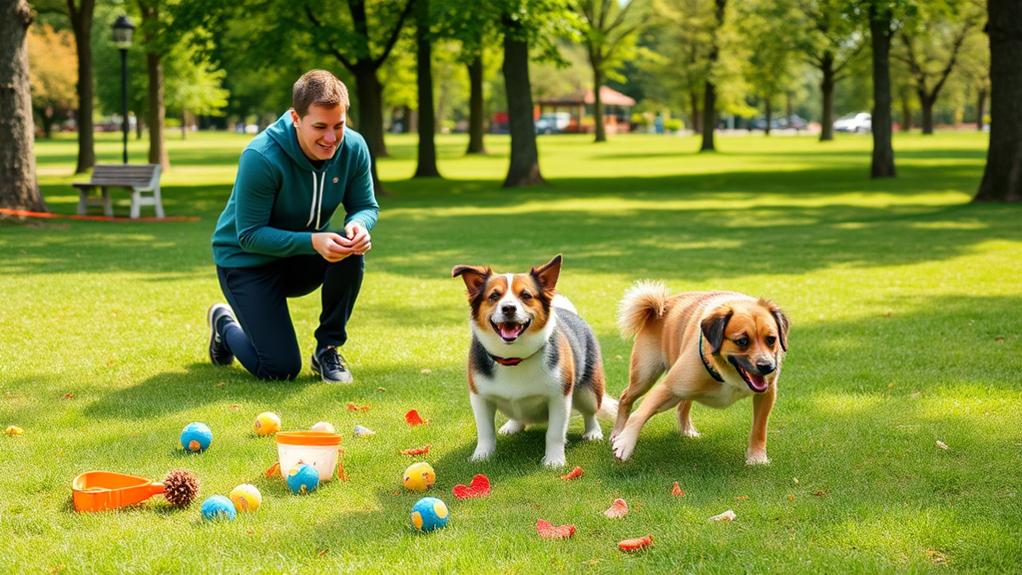To keep your dog training sessions short and effective, start by setting clear and realistic goals. Choose a distraction-free environment to help your pup focus. Use positive reinforcement, rewarding desired behaviors immediately with treats or praise. Incorporate breaks after every 10-15 minutes of training and limit sessions to 5-15 minutes to maintain interest. Keep training fun by including games or new tricks, and track your dog's progress to make necessary adjustments. With these tips, you'll nurture a positive learning experience. Curious about more ways to enhance your training sessions? There's plenty more to discover!
Set Clear Goals
When you begin your dog training journey, it is essential to set clear goals right from the start. Defining specific objectives helps you stay focused and measure your progress. Think about what behaviors you want to teach your dog, whether it's basic commands like "sit" or more complex tricks.
Make sure your goals are realistic and achievable. If you aim too high too quickly, you might set both yourself and your dog up for frustration. Break down larger goals into smaller, manageable steps. For example, if you want your dog to master "stay," start with short durations and gradually increase the time.
Additionally, prioritize your goals based on your dog's needs and your lifestyle. If your dog struggles with leash manners, focus on that before moving on to other skills.
Keep your goals flexible, too. As you progress, you might find that some objectives need adjustment based on your dog's learning pace or changing circumstances. Remember, training should be a positive experience for both of you. By setting clear goals, you create a roadmap for success, making your training sessions more effective and enjoyable.
Choose the Right Environment

Choosing the right environment for dog training is crucial, as it can greatly influence your dog's focus and learning ability. Start by selecting a space with minimal distractions. A quiet room or a secluded area in your backyard can help keep your dog's attention on you and the tasks at hand. If you're training outdoors, avoid busy parks or crowded areas, especially if your dog is easily distracted by other dogs or people.
Additionally, consider the temperature and weather conditions. Training in extreme heat or cold can make your dog uncomfortable and less willing to engage in the session. Aim for a comfortable environment where your dog feels at ease.
It's also essential to think about your dog's familiarity with the space. Training in a location your dog knows can help reduce anxiety, allowing them to focus better on learning. You can gradually introduce new environments as your dog becomes more confident and skilled.
Lastly, always ensure the training area is safe. Remove any hazards that could potentially harm your dog, and be mindful of their surroundings. By choosing the appropriate environment, you're setting both you and your dog up for success.
Use Positive Reinforcement
Positive reinforcement is a powerful tool in dog training that encourages desired behaviors through rewards. When you reward your dog for good behavior, you're not only reinforcing that behavior but also building a strong bond of trust and communication. Use treats, praise, or toys as rewards to motivate your dog. This approach makes learning enjoyable for them and can speed up the training process.
Start by identifying the behaviors you want to encourage. When your dog sits, stays, or performs a trick, immediately reward them. Timing is pivotal; the reward should come right after the behavior to help your dog make the connection. If your dog doesn't respond right away, don't get frustrated; instead, be patient and consistent.
Mix up the rewards to keep your dog engaged. Sometimes a favorite treat may work wonders, while other times, enthusiastic praise or playtime might be more effective. Remember, every dog is unique, so what works for one may not work for another. Keep an eye on what excites your pup the most and use it to make your training sessions both short and effective. Positive reinforcement creates a happy learning environment for you and your furry friend.
Incorporate Breaks

Incorporating breaks during training sessions is essential for keeping your dog engaged and preventing fatigue. Just like you, your dog needs time to relax and recharge. Short breaks help your pup process what they've learned, making it easier for them to grasp new commands and skills.
During these breaks, let your dog enjoy some downtime. You can offer a favorite toy, engage in light play, or simply allow them to sniff around. This helps maintain their enthusiasm and interest in the training session. It's also a great opportunity for you to observe your dog's body language and energy levels. If they seem restless or distracted, it might be a good time to take a break.
Aim for a five-minute break after every 10-15 minutes of training, adjusting as needed based on your dog's attention span and energy. Keep it fun and relaxed; this isn't the time for corrections or discipline. Instead, focus on positive interactions that strengthen your bond. By incorporating breaks, you'll create a more enjoyable training experience for both you and your dog, leading to better results in the long run.
Limit Session Duration

To achieve effective training, it's crucial to limit session duration. Dogs, especially young ones, have short attention spans, and long sessions can lead to frustration for both you and your pup. Aim for sessions that last between 5 to 15 minutes, depending on your dog's age and energy level.
During these brief training periods, focus on a specific command or behavior. This approach helps your dog grasp the concept without becoming overwhelmed. If your dog shows signs of losing interest—like wandering off or becoming distracted—it's time to end the session.
You can always return for another short session later in the day. Consistency is key, so try to train multiple times throughout the week, even if each session is short. This method reinforces learning and keeps your dog engaged.
Keep Training Fun

Short training sessions can be a great opportunity to keep things lively and enjoyable for your dog. To make the most of these moments, incorporate play into your training routines. Use toys, treats, or even a game of fetch to motivate your pup. When your dog associates training with fun activities, they're more likely to stay engaged.
Don't be afraid to mix things up! Introduce new tricks or commands to keep your dog curious and excited. If they already know a command, try adding a fun twist, like practicing it while running around the yard. This keeps their mind sharp and their spirits high.
Also, remember to celebrate successes, no matter how small. Give praise, treat rewards, or a quick game break when your dog accomplishes a task. Positive reinforcement makes training enjoyable and encourages them to learn more.
Lastly, stay upbeat and energetic during the sessions. Your enthusiasm is contagious! If you're having fun, your dog will too. By creating a dynamic and enjoyable training atmosphere, you'll foster a love for learning that will last a lifetime. Keep it fun, and watch your dog thrive!
Track Progress and Adjust

Tracking your dog's progress during training sessions is critical for understanding what works and what doesn't. By keeping a record of your dog's achievements and challenges, you'll gain valuable insights into their learning style and needs. Start by noting the specific commands or skills you're working on, and document how your dog responds over time.
After each session, take a moment to jot down observations. Did they grasp a new command quickly, or did they struggle? Were there distractions that hindered their focus? This information helps you adjust your training techniques for better results.
If you notice your dog excels at certain commands but struggles with others, consider altering your approach. Maybe they need shorter sessions, more frequent breaks, or a different reward system.
Conclusion
By following these tips, you'll make your dog training sessions shorter and more effective. Set clear goals, choose the right environment, and use positive reinforcement to keep your pup engaged. Remember to incorporate breaks and limit session duration to avoid overwhelm. Keeping training fun will strengthen your bond, and tracking progress helps you adjust as needed. With a little patience and consistency, you'll see great results in no time! Happy training!



